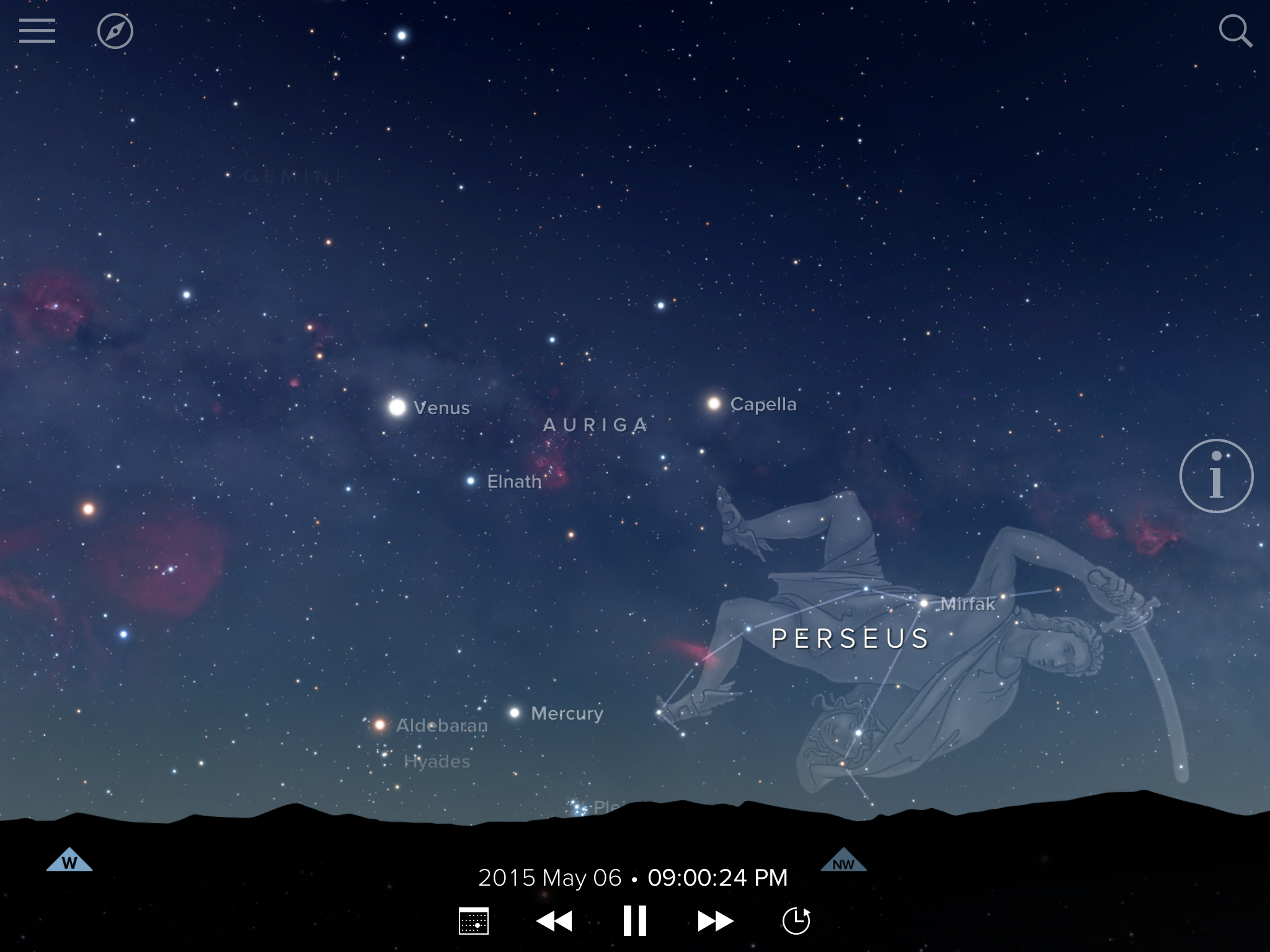HUNTING THE FASTEST PLANET
by Darrell Heath
Let’s go planet hunting! But not just any planet, we are going to hunt down the most elusive of the naked eye planets in our solar system: Mercury.
Mercury can be a bit tricky to find at most times because it stays very close to the Sun. Due to it being the innermost world it only takes Mercury 88 Earth days to complete one lap around the Sun. As it races around our parent star every two months it will briefly swing out far enough in its orbit to make itself visible either during the morning hours just before sunrise or during the early evening right after sunset. On some occasions it is so close to our horizon that we never get a good look at it and on others it will climb high in the sky that spotting it becomes much easier. On May 6th and 7th we get one of those times when Mercury is in primetime evening viewing mode. In fact, on these two dates Mercury makes its best evening appearance for the entire year.
Here’s how to spot it. First, find your self a clear, and unobstructed view of the western horizon. On the evening of May 6th or 7th go outside at around 7:45PM and watch where the Sun sets (use a landmark of some kind if possible). Now wait about 45 minutes to an hour after sunset and go back outside and look again to the west at the point where the Sun set earlier. Let your eye wander a bit to the left (east) of where the Sun set and then up by about 10 degrees above the horizon (10 degrees is the width of your fist held out at arms length), there you should see a fairly bright ‘star’ glowing in the dark. That isn’t a star though; it’s the planet Mercury. Above and to the left of Mercury (about 15 degrees or so) you will see the brightest ‘star’ in this part of the sky. Once again, this isn’t a star; it is the second of the innermost planets, Venus. You can pretty much draw a line between the two. 
You can use a pair of binoculars to help spot Mercury during the early moments after sunset but your best bet for locating it (provided the horizon is free of clouds) will be an hour after the Sun has gone down. If you do try to spot it early on in the evening then be very careful while using binoculars, you will want to make sure that the Sun is well below the horizon before using any kind of optical aid. All it takes is a momentary glance at the Sun with the binoculars to do permanent damage to your eyes.
Through a telescope you will see a small disc that is about 35% illuminated. Yes, we get to see the innermost planets go through a set of phases just like the Moon! And the same safety warnings apply here as well. After putting on such a lovely show Mercury will soon fade and disappear over the next couple of weeks as it heads back into the bright twilight. If you don’t get to see Mercury either naked eye or with optical aid this go around then check back at the end of the year on the evening of December 29th for another fine showing. Who knows, if you’ve been minding your P’s and Q’s you might end up on Santa’s list of good boys and girls and find a telescope under your tree at Christmas!
Here are some cool things to think about as you look for Mercury.
- Mercury is 3,032 miles in diameter, 38% that of the Earth.
- Mercury’s orbital shape is very elliptical which means that at its closest distance to the Sun it is about 36 million miles away and when it is at its furthest it is about 43.5 million miles distant.
- This small planet closely resembles our own Moon. Both are dead, airless worlds covered in craters, lava plains and steep cliffs.
- One of the largest impact craters in the solar system is Mercury’s Caloris Basin, which is 960 miles wide. The crater was formed approximately 3.9 billion years ago when an asteroid estimated to be about 62 miles wide struck the planet.
- While Mercury orbits the Sun in only 88 Earth days it rotates upon its axis very slowly: about 59 Earth days. The combination of a swift orbit and slow rotation means that if you were on the surface of Mercury it would take 176 days from one sunrise to the next. The Sun would appear two and half times bigger than it would from here on Earth.
- Mercury has very little tilt to its axis so it has no seasons like many of the other planets. Dayside temperatures are around 800 degrees Fahrenheit while the night side drops to -290 degrees Fahrenheit.
- Despite the high daytime temperatures there is water ice inside some of Mercury’s craters that are kept in perpetual shadow. This water must have been delivered to the planet’s surface via comets and asteroids.
- We have only sent two spacecraft to Mercury. In the 1970’s NASA’s Mariner 10 flew by the planet three times, taking images and mapping the surface.
In 2004 NASA launched the Messenger spacecraft to Mercury and it began orbiting the planet and collecting scientific data in 2011. Its mission now over the space agency deliberately crashed Messenger into Mercury’s surface on April 30th of this year.
